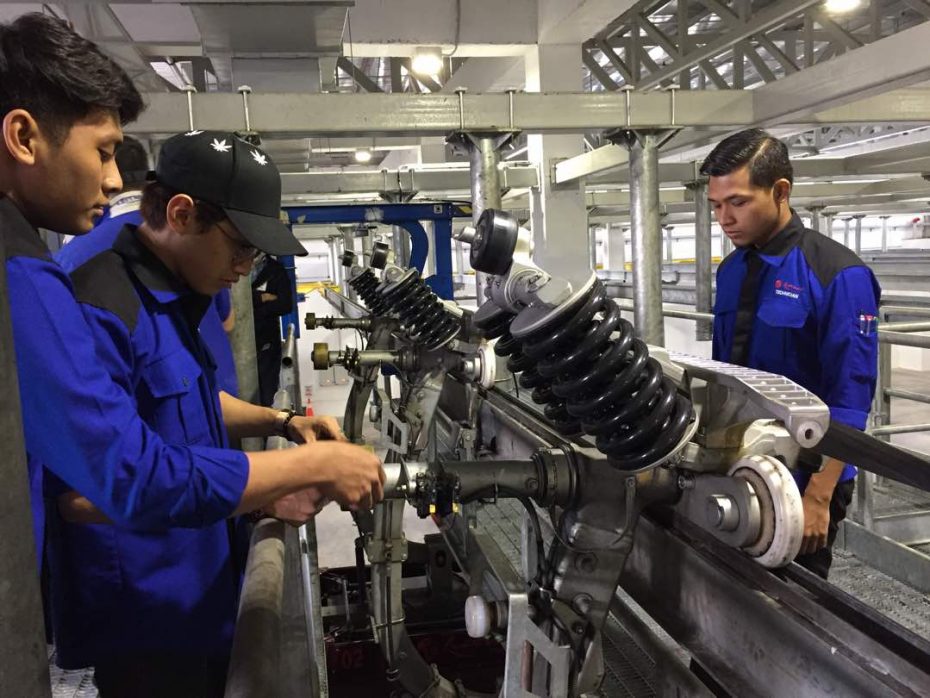by TEAM SATPAL
THE first thing one notices when approaching Resorts World Genting (RWG) by car are the strings of gondolas gliding up the mountainside, floating above the occasional fog that clouds the area.
Open in December 2016, the Awana SkyWay consists of 2.8km of tensioned cables made of galvanised steel. One hundred gondolas run the route at an average speed of four metres per second, with a top speed of six metres a second.
Each French-made gondola supports a maximum weight of up to 900kg, with a limit of 10 passengers per car (the 10 glass-bottomed gondolas have a lower seating limit of six).
According to Megat Ariffuddin, Awana SkyWay assistant technical manager for RWG, the cable car system can transport an average of 3,000 passengers per hour. The Awana SkyWay staff carries out stringent safety and maintenance checks throughout each day, with two particularly thorough checks.

Maintenance workers greasing the rollers with full concentration to ensure the cable car moves smoothly.
The first intensive safety check is arguably the most important, carried out in the wee hours by the pre-opening team, from 5am to 7am, and includes a brief update on the day’s activities, and a visual checking of tyre pressure, belting and cable tension.
The second intensive check starts an hour before closing time at 11pm and ends at 7am.
The Awana SkyWay gondola system has four stations but only three are for public usage – the Awana, Chin Swee and SkyAvenue stations. The fourth station, known as the turning or Main Drive station, is solely used by the technical team for maintenance and system control.
The main control panel at the turning station looks like something out of a Star Wars film – a grey board garnished with a plethora of colourful buttons, a variety of levers and a monitor – which receives and processes data from all the other stations.
An entire map of the route is displayed on the screen, with each gondola indicated by a red dot and number. This is the nucleus of the Awana SkyWay system, with complete control over all aspects of the ride.
Any change or update to the system happens here. In the case of emergencies, it can isolate or halt all activities when flashing red lights indicate a problem.
Each of the four stations has a sub-store, containing spare parts for use in emergencies. The turning station also has its own power supply in case of electrical disruption, with a dedicated incoming power supply from Tenaga Nasional Berhad and a secondary backup diesel engine. These backup systems only come into play if passengers need to be evacuated from gondolas during power outages.
All members of the Awana SkyWay technical team have a licence certifying them as part of the maintenance crew. They are required to sit for regular tests to keep them on their toes.
“The gondolas are completely safe,” said Megat. “Each gondola undergoes numerous safety checks before passengers are allowed on board. Any potential errors would also be immediately detected by our control panel.”
Bad weather does not prevent the Awana SkyWay from operating. In such cases, the team keeps in constant communication through speakers in individual gondolas, informing passengers of operational matters.
The technical team monitors the ride closely during such periods, and will halt all activities when winds blow at speeds exceeding 40km per hour. Gondolas would be slowed until all passengers are deboarded.
The ride would then be completely halted until a green light is given to restart the system. In the unlikely case of passengers being stranded on board a gondola during terrible weather conditions, a rescue team is manually deployed to scale the cables and evacuate the passengers.
As Awana SkyWay celebrates its first anniversary of operation, safety remains the top priority for the team behind the ride.

